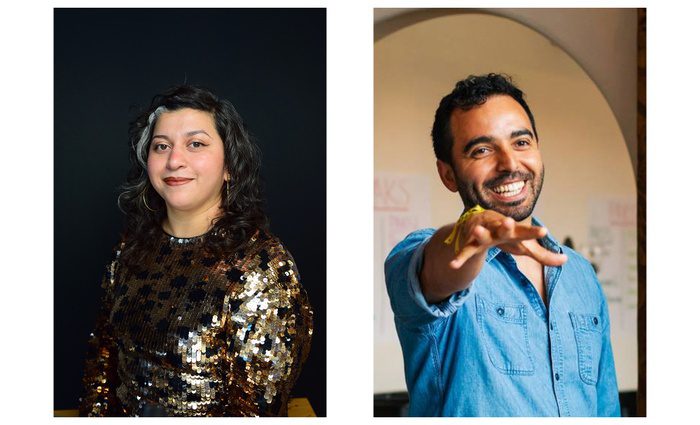School of Art fellows draw attention to climate change with cooling paint murals
The Climate Engagement through Art in Cities fellows will create murals with reflective paint in the hottest neighborhoods in New Haven to spread awareness for climate change.

Yale News
Two newly-announced fellows at the School of Art will be painting to protect the planet, placing murals around the Elm City to promote climate consciousness — and cool the environment.
Victoria Martinez ART ’20 and Daniel Pizarro ART ’12 were announced on Sept. 29 as the first ever recipients of the Climate Engagement through Art in Cities fellowship, a cooperative project between the School of Art, School of Architecture and the School of the Environment.
The one-year fellowship runs from Sept. 2022 through Aug. 2023 and will engage the fellows in dialogues with the New Haven community to devise artwork that raises awareness of climate change. With its use of cooling reflective paint, the project will also be kicking off an urban science experiment to explore how cities can adapt to global warming.
“The arts move people,” said Karen Seto, Frederick C. Hixon Professor of Geography and Urbanization Science and a key organizer of the fellowship. “Be it music, sculpture or painting, they move people. The idea is to use art to stir the public about climate change and see the science alongside.”
According to Seto, the initial idea was spurred by a feeling that the empirical data and research on climate change weren’t reaching enough people. Seto realized art had the potential to fill in the gap between scientists and the public. From there, the project evolved into a collaboration with the School of Art and School of Architecture intending to explore new means of communicating science.
Alongside science communication, the creation of the artwork will examine the science of how cities can combat climate change. To this end, the mural will be made with paint engineered to cool its surroundings by reflecting ultraviolet and near-infrared radiation.
“The project is like a Russian nesting doll,” Seto said. “It started off as an art project to engage the community, and then we came across cooling paints and found the next doll: what if we cooled buildings with murals? And why don’t we cool buildings in the hottest neighborhoods in the city? And from there on, we kept discovering new possibilities, from environmental justice to community engagement.”
The Yale Center for Earth Observation will help test the project’s hypothesis. By flying thermal sensing drones across the city sky, YCEO will record the heat emanating from city neighborhoods before and after the mural’s completion.
Tarek Kandakji, a remote sensing specialist at YCEO, explained that the multispectrum drones will help provide a quantification of city heat in terms of thermal energy. The data collected thereby will allow them to track the temperature across time and study the cooling effect on the city’s climate, if any, from the mural.
“When I was offered the [fellowship,] I was immediately excited about imagining the possibilities of art and architecture woven through the city landscape,” Martinez told the news. This will be my first public art project working at such a large scale with the City of New Haven. I have led and facilitated public art projects over the course of my career. I look forward to working with Yale to create a public art project that includes the communities of New Haven.”
As Climate Engagement Fellow, Martinez will bring together her artistic background with the inputs of New Haven’s community to come up with the mural’s design.
Textiles play a crucial role in Martinez’s artwork. The Chicago native believes in the power of fabric to bring together all backgrounds and cultures. She envisions her mural in a similar vein — a metaphorical quilt bringing together the local communities and their diverse ethnic backgrounds.
“In terms of mural aesthetics, I am envisioning patterns, textures and color palettes inspired by my research on the expansive history of textiles.” Martinez said. “I would love to incorporate plants and trees into the public art project. In addition to the incorporation of experimental cooling paint, I plan to incorporate nature as an art material and share it with those who experience the piece. I would like the mural to be a neighborhood landmark, a site of engagement, where people experience art and can enjoy the oxygen coming from the trees. I hope this mural can expand into a contemporary classroom for the public.”
On the other hand, Pizarro — a New Haven long-time resident — will helm the project’s graphic identity and creative strategy as Communications Design Fellow. He will also document Martinez’s creative process, from the initial mockups to the painting of the mural.
Previously, Pizarro has tackled issues in the Latinx communities in his design practice, with projects on COVID-19 vaccine equity and the housing evictions crisis. He centers his work on topics of race, class and the urban environment, with an emphasis on bilingual design.
“The biggest design challenge is developing new and effective ways of communicating climate change to
those communities that will be most impacted” said Pizarro. “As the eldest child of immigrants from Chile, I grew up in an environment of translation, and I bring that into my design work. I look forward to leveraging the networks I have made in New Haven to make this project a success.”
The fellowships are funded by the Yale School of Art and the Climate Impact Innovation Fund and are made possible through the Yale Planetary Solutions Project.







